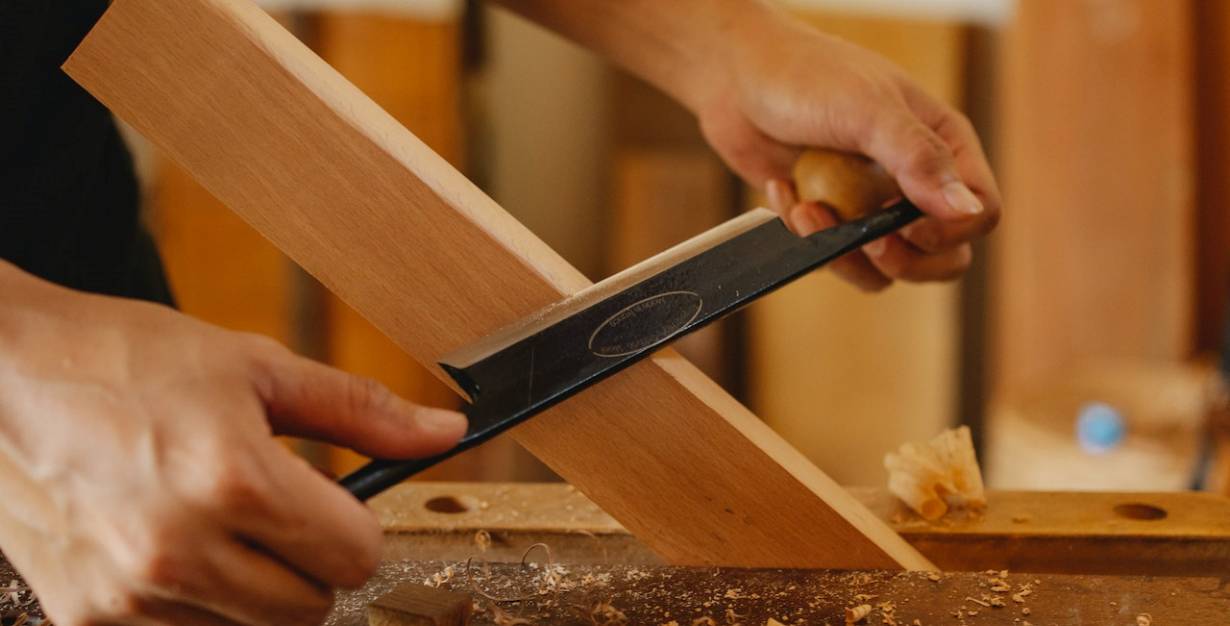Woodworking is a craft that has been around for centuries, and while many modern woodworkers have turned to power tools to speed up their work, there’s no denying the importance of hand tools in this field. For starters, hand tools allow for more precision and control when working with wood. They also offer a sense of connection to the material and a feeling of satisfaction when you create something with your own two hands.
In this guide, we’ll be taking an in-depth look at the essential hand tools every woodworker should have, as well as some more advanced and niche options that can elevate your woodworking game. Whether you’re a beginner just starting out or an experienced woodworker looking to expand your tool collection, this guide is designed to help you make informed decisions about which tools to invest in.
Why Hand Tools Matter
At its core, woodworking is all about shaping raw pieces of wood into functional or decorative objects. And while power tools like table saws and drills certainly have their place in this process, there’s a certain magic that comes from using hand tools. When you’re working with chisels and planes instead of motors and blades, you’re forced to slow down and really pay attention to what you’re doing.
You can feel the texture of the wood under your fingertips and adjust your cuts accordingly. Beyond the tactile experience, hand tools also give you more control over your workpiece.
You can make tiny adjustments without worrying about accidentally removing too much material or causing damage with a power tool. And because there are no cords or batteries involved, hand tools are often more portable than their electronic counterparts – perfect for taking on-the-go or setting up shop outside.
Structure of The Guide
Now that we’ve established why hand tools matter in woodworking let’s talk about how we’ll be approaching this guide. We’ll start by discussing the most essential hand tools that every woodworker should have in their arsenal, from hammers and saws to chisels and measuring tools. We’ll cover what each tool is used for, how to choose a high-quality version and some tips for using them effectively.
From there, we’ll move on to more advanced hand tools that can take your woodworking to the next level. These are the tools that may not be strictly necessary but can make certain tasks much easier or allow you to achieve more intricate designs.
We’ll also discuss niche hand tools that aren’t as commonly used but can be incredibly helpful in certain situations. We’ll wrap up with some tips on how to care for and maintain your hand tools so they last a lifetime.
After all, investing in high-quality tools is only worth it if you take care of them properly. By the end of this guide, you should have a good understanding of which hand tools are right for you and how to get the most out of them.
Essential Hand Tools for Woodworking

The Must-Have Tools in Your Arsenal
Whether you’re a professional or an amateur woodworker, a set of essential hand tools is vital to have in your arsenal. These tools will help you complete your woodworking projects with accuracy and precision. Here are some of the most important hand tools you should consider having:
Hammer
A hammer is one of the most basic and essential hand tools for woodworking. It helps you drive nails into wood securely, and it’s also useful for removing or adjusting nails if needed. A good quality hammer should be comfortable to handle and have a balanced weight distribution.
Saw
A saw is another important tool that every woodworker should have. Different types of saws include cross-cut saws, rip saws, panel saws, etc., each designed for different purposes. When selecting a saw, consider blade thickness, tooth shape and spacing since these properties affect the accuracy and quality of cuts.
Chisel
A chisel is used to shave off small amounts of wood to create delicate details within your project. The blade’s edge needs to remain sharp at all times as dull chisels can ruin the project’s finish or even cause injury.
Detailed Descriptions and Uses for Each Tool
Let’s take a closer look at each essential hand tool for woodworking. The hammer comes in many varieties such as claw hammers used primarily by carpenters to frame houses; ball-peen hammers with one round face used to shape metal; sledgehammers with two large heads designed for breaking apart materials; etc. When it comes to saws, there are many types available including circular saws with blades similar to those on table saws; miter saws that pivot to create angled cuts; coping saws for intricate cuts; etc. The different saws have their own unique purposes.
Chisels come in various shapes and sizes, each designed for a specific task. Some of the most common ones include bench chisels used to remove large amounts of wood, while smaller ones like mortising chisels are made to carve deep grooves into wood.
Tips for Selecting High-Quality Versions of Each Tool
When it comes to selecting high-quality hand tools, consider your budget and intended use. You don’t have to spend a fortune on each tool, but it’s best not to skimp on quality either. Durability is important as you want tools that can withstand frequent use.
Look for hand tools with comfortable grips that fit your hand size and shape well since you’ll be working with them for extended periods.Plus, ensure the blades are made from high-quality materials as this will affect how well they hold an edge when sharpened. Having essential hand tools in your woodworking arsenal is a must-have whether you’re a professional or an amateur woodworker.
Ensure that each tool is of good quality by considering factors such as durability, comfort, and blade material when purchasing them. With these tips in mind, you’ll be well on your way to creating beautiful woodworking projects with ease!
Advanced Hand Tools for Woodworking
A Cut Above the Rest: Hand Planes
For the more experienced woodworker, hand planes can be an indispensable tool. A hand plane is essentially a woodworking tool that allows you to shave off thin layers of wood to achieve a smooth surface.
They come in different shapes and sizes, each with its own unique purpose, such as smoothing out rough surfaces or creating straight edges. One of the most important things to consider when selecting a hand plane is its blade.
Look for high-quality blades made from durable materials like high-carbon steel or laminated steel. Other key features to consider include the size and shape of the plane’s body and the type of adjustments that it offers.
Smooth Operator: Spokeshaves
Spokeshaves are another specialized tool that can help you achieve smooth, precise curves in your woodworking projects. They’re typically used for shaping chair legs, handles, and other curved pieces of wood.
When selecting a spokeshave, look for one with a comfortable grip and adjustable blade depth. The blade should also be made from durable materials like high-carbon steel or laminated steel.
The Rougher Side: Rasps
Rasps are another type of advanced hand tool that can be useful in certain situations. They’re essentially files with coarse teeth that allow you to quickly remove unwanted material from your workpiece.
When selecting a rasp, look for one with sharp teeth that will cut through wood cleanly. You should also consider the shape and size of the rasp – flat rasps are great for removing large amounts of material quickly, while round rasps are better suited for shaping curved surfaces.
Overall, these advanced hand tools require some skill but can greatly enhance your abilities as a woodworker. By choosing high-quality versions of each tool with features tailored to your specific needs, you’ll be well-equipped to tackle even the most challenging woodworking projects.
Niche Hand Tools for Woodworking
Old-School Tools with Modern Applications
While most woodworkers rely on a standard set of hand tools, there are some less common tools that can be incredibly useful in certain situations. One such tool is the drawknife, which has been used by woodworkers for centuries.
Drawknives are essentially long blades with handles on both ends that can be used to shave and shape wood quickly and efficiently. They’re particularly useful when working with curved or irregularly-shaped pieces of wood, as they allow you to remove material quickly and accurately.
Another old-school tool that’s still popular among woodworkers today is the froe. Froes are essentially large cleavers that are used to split green logs into smaller sections for woodworking projects.
They’re particularly useful when working with greenwood, as they allow you to split the wood while it’s still moist and easy to work with. While froes may not be useful for every project, they’re a great tool to have in your arsenal if you’re planning on doing any traditional woodworking.
Specialty Tools for Specific Tasks
In addition to traditional hand tools, there are also several specialty tools that can make certain tasks much easier. One such tool is the birdcage awl, which is used to create holes in wooden dowels or other cylindrical objects.
Birdcage awls have a hollow shaft with a small blade at the end that allows you to drill precise holes without damaging the surrounding material. Another specialty tool that many woodworkers swear by is the spoon gouge.
Spoon gouges are similar to chisels but have a curved blade that allows you to carve intricate designs into wooden surfaces. They’re particularly useful when creating ornate details on furniture or other decorative items.
Choosing High-Quality Niche Tools
When it comes to selecting niche hand tools for your woodworking projects, it’s important to choose high-quality versions of each tool. While you may be able to find cheaper versions of some tools online or at your local hardware store, these tools are often poorly made and won’t last as long as higher-quality options. One way to ensure that you’re getting a high-quality tool is to look for brands that are well-respected in the woodworking community.
For example, many woodworkers swear by tools made by Lie-Nielsen or Veritas, as they’re known for their exceptional quality and durability. Additionally, it’s important to read reviews from other woodworkers before making a purchase, as this can help you determine whether a particular tool is worth the investment.
Care and Maintenance of Hand Tools
Why Proper Care is Important
Taking care of your hand tools is essential to ensure that they last a long time. Regular maintenance not only extends the lifespan of your tools, but it also prevents damage and improves their performance.
You’ll find that with proper care, your hand tools will function much better, making it easier for you to work on projects. Another reason why proper care is essential is that it can help save you money in the long run.
Replacing broken or damaged tools can be costly, but regular maintenance can prevent these expenses. Taking good care of your hand tools means that they will continue to be reliable and efficient for years to come.
Step-by-Step Instructions on How to Clean and Maintain Different Types of Hand Tools
Maintaining hand tools isn’t always easy, but if you follow a few simple steps, you’ll find that it’s not as complicated as you thought. The first step in maintaining your hand tools is cleaning them regularly. It’s important always to clean your hand tools after use because dirt and debris left on them can cause rust over time.
For metal parts like blades or chisels, use a mild solvent like mineral spirits or rubbing alcohol to remove any dirt or grease buildup. For wooden handles, simply wipe them down with a damp cloth and allow them to air dry completely before storing them away.
Tips on How to Sharpen Blades Effectively
Blades are one of the most important components in many woodworking projects; therefore, ensuring they are sharp is critical. A dull blade makes cutting difficult and leads to inaccuracies in your work. To sharpen blades effectively requires some skill, but even beginners can learn how with practice!
The best way to sharpen blades depends on the type of tool involved; however, the general rule of thumb is to use a sharpening stone or honing guide for sharpening flat blades such as chisels or plane irons. For curved blades, such as those found on carving knives, honing can be done using a leather strop.
Proper care and maintenance of hand tools is crucial if you want them to perform at their best. Always make sure that you keep your tools clean and store them in a dry place away from moisture.
Remember to follow the manufacturer’s instructions on how to care for specific tools, especially when it comes to sharpening. With these tips in mind, your hand tools will always be ready whenever you need them!
Conclusion
After reading this comprehensive guide on hand tools for woodworking, we hope you feel more confident in selecting and using the right tools for your projects. Remember, while power tools may be faster and more efficient in some cases, there is something special about using hand tools. They allow you to connect with the wood and create something truly unique.
We covered the essential hand tools every woodworker should have in their toolbox such as saws, hammers, chisels, and more. We also delved into advanced hand tools like spokeshaves and rasps that can enhance your woodworking abilities.
We discussed niche hand tools like drawknives and birdcage awls that some woodworkers may find helpful. It’s important to remember that proper care and maintenance of these hand tools is necessary to ensure their longevity and effectiveness.
Make sure to clean them after each use and sharpen blades when needed. Overall, we hope this guide inspires you to experiment with different types of hand tools in your projects.
Learning how to use them effectively can take time but it’s a rewarding experience that can improve your woodworking skills tremendously. Happy crafting!



